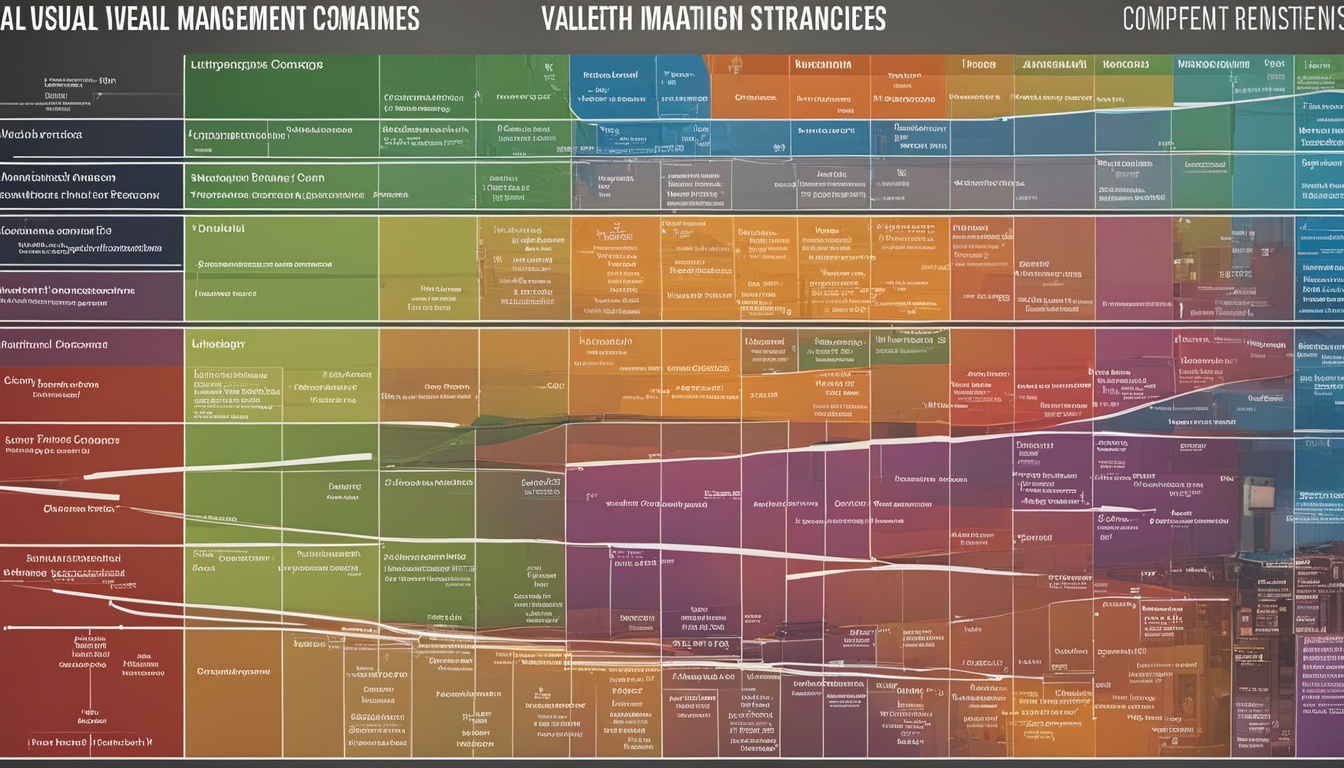Valuing a company using multiples is popular in the finance world. It works on the idea that if companies are similar, their values should be too. So, financial information from other firms helps figure out the analyzed company’s worth. There are two key methods for this: Comparable Company Analysis (CCA) and Comparable Transaction Analysis (CTA).
CCA compares the target company with others in the same industry using various ratios. Deciding which companies are true peers can take a lot of time. CTA, however, looks at past deals of similar companies to set the valuation multiples.
Special tools like Valutico are often used by experts to get these multiples. But, this method has its downsides. Things like data access, finding the right peers, and focusing on the past, not the future, can make valuations less accurate and reliable.
Key Takeaways:
- Wealth management often uses multiples to estimate businesses’ values.
- Comparable Company Analysis (CCA) and Comparable Transaction Analysis (CTA) are important methods for this.
- Experts use tools like Valutico to find the necessary multiples for their work.
- Data availability and choosing the right comparison companies are critical.
- Valuing with multiples looks at what companies have done in the past, not what they might do in the future.
What is Valuation Using Multiples?
Valuation using multiples is among the key ways to assess a business. It is part of the market-based approach. This method uses the idea that companies in the same field are worth about the same. So, we look at the financial details of similar companies to guess at a company’s value. We then compare these to the company we are valuating.
This method is favored for being simple and practical. It quickly gives an idea of a business’s worth. It works well when many similar businesses with clear financial details are available.
However, picking the right comparison companies for their financial data can be tough. Valuation experts look for companies in the same industry and of about the same size. They must also consider how fast these companies can grow and their financial health. This choice makes sure the valuation using multiples is accurate.
Valuation using multiples works best in fields where companies are buying and selling or on the stock market. Here, by comparing a company to others, we can get a good guess at its value.
“The valuation using multiples approach enables an efficient and reliable estimation of a company’s value by leveraging the financial performance of comparable companies in the market.” – Valuation Expert
This method is unlike others, like the discounted cash flow (DCF) method. DCF looks at future earnings, while valuation using multiples looks at a company’s current value based on its financial health compared to similar companies.
Let’s look at an example to make this clearer. Take a fintech startup. If there are fintech companies on the stock market with similar business models and growth, we can use their price-to-earnings (P/E) ratios. We compare these companies to find an average P/E ratio. Then, we can apply this average to the startup’s earnings. This gives us an estimate of the startup’s value.
This method offers a simple way to figure out a business’s value. Still, it’s crucial to know its limits. The reliability and accuracy of the valuation can be affected by many factors. Each industry and company is unique. Their special features must be thought about carefully when picking comparison companies and using multiples.
There are tools like Valutico that can help make this process easier. Such platforms have a lot of financial data from companies for comparison. They speed up and improve the valuation process.
In the end, valuation using multiples is a powerful tool for those looking after wealth. Knowing how the market-based approach works helps investors make better choices. This can improve their investment plans and lead to a stronger financial future.

Pros and Cons of Valuation Using Multiples
Valuation using multiples has its good and bad sides when it comes to figuring out a company’s value. Investors and valuation experts need to know both to make smart choices.
Advantages of Valuation Using Multiples
- Simplicity: It’s an easy way to figure out a company’s value. You just compare it to similar ones in the same business and you get a quick idea.
- Quick estimation: By looking at the annual reports of similar companies, you can quickly estimate a company’s value. This is great when you’re short on time.
Disadvantages of Valuation Using Multiples
- Limited data availability: One big issue is not always having enough data for a good comparison. It’s hard to find similar transactions with the needed numbers.
- Peer comparison: Choosing the right companies to compare can be tricky. It’s not always clear which ones are truly similar, making the value estimate less accurate.
- Orientation towards past performance: This method looks mostly at what a company has done in the past. This can miss the mark on future growth or challenges the company might face.

Valuation using multiples has clear benefits like being simple and quick. However, it also faces challenges with data and picking the right companies to compare. The focus on past rather than future can be a drawback too.
It’s key to be aware of the pros and cons when using this valuation method. Knowing its limits and potential flaws helps investors avoid mistakes. This way, they can better understand a company’s real value.
Comparable Company Analysis Formula
Comparable Company Analysis (CCA) is used a lot in wealth management. Here’s how it works. You pick a financial number from the company you’re looking at. Then, you check out similar companies to set a standard.
First, pick a key financial number from the company. Think of things like how much money they make or their profits. This number is used to compare it to others.
Next, you need to compare with similar companies in the same line of work. They should be close in size, what they do, and how they’re expected to grow. These firms will help set the right value.
After finding similar companies, you need to calculate a special number. It’s based on what the market thinks these similar companies are worth, compared to their financial number. For example, if a similar company is worth $100 million with $20 million in revenue, the number is 5x.
Then you apply this special number to the original company’s financial number to guess its value. Say the company you’re looking at has $15 million in revenue. Using the 5x number, its value would be guessed at $75 million.
Using more than one company makes the guess more accurate. But, finding just one very similar company and using its number can still give a good estimate.
“While the Comparable Company Analysis formula seems easy, the real challenge is finding really alike companies. Knowing the industry well and doing a detailed analysis is key to getting it right.”
By using this formula, financial experts can make smart choices for their clients. They can better understand how much companies in their care are really worth.
Approaches to Valuation for Wealth Management Firms
Wealth management firms have very few physical assets, which makes the asset approach not a good fit for their valuation. Instead, we use the income and market approaches to determine their worth. These methods consider the firm’s earnings and its value compared to others on the market.
The income approach looks at the firm’s financial history or future predictions to find its value. It uses cash flow analysis. This method looks at the firm’s growth, profits, and risks to estimate its current worth.
“The income approach allows us to assess the earning potential and ability of wealth management firms to generate cash flow, which is a crucial consideration in determining their value.”
The market approach instead uses sale prices or public company values like a guide to the firm’s worth. It compares the firm to others that are alike and have been sold or are on the stock market. This helps investors guess the wealth management firm’s value.
Each method, the income and market approaches, needs different information and ways of looking at it. The income way looks at how well the firm does inside, and the market part looks at how it compares to the industry. Using both can lead to a better idea of the wealth management firm’s true value.

Note: The image above visualizes the different valuation approaches used for wealth management firms.
Key Drivers of Value in Wealth Management Firms
In the world of wealth management firms, success comes from understanding key drivers. These drivers help firms grow and bring in clients.
Recurring Client Base
Keeping clients for the long term is important for these firms. It means they have steady income from loyal clients. Firms that keep their clients happy over time are more valuable.
Revenue Growth
Growing their income steadily is a big deal for wealth management firms. It shows they can keep clients happy and draw in new ones. This success means more value for the firm.
Size of Firm
A firm’s size affects how much it’s worth. Bigger firms have more to offer. They have more clients, services, and resources, making them more valuable.
Client Demographics
The types of clients a firm has can change its value. Firms serving many different types of people can find more opportunities. This makes them less risky and more valuable in the market.
Compensation and Expenses of Management
How a firm handles its money and pays its leaders matters. Well-run firms that use money wisely are more attractive. But a firm that spends too much on its leaders or wastes money loses value.
Life Stage of the Company
Where a firm is in its growth affects its worth. New firms are promising but may not have a proven track record. Older firms with a good history and reputation are seen as more stable and successful, which increases their value.

Use of the Market Approach to Value Wealth Management Firms
The market approach is key when valuing small to medium-sized wealth management firms. It uses two main methods: the transaction multiple method and the guideline public company method.
The first method looks at similar private firms in the same industry. By studying these firms, experts can find useful numbers. These numbers help figure out the wealth management firm’s value.
But another way is to look at public companies. This method uses the stock market and company ratios to work out the firm’s worth.
Yet, using these methods needs care. They have their good and not so good points for getting the right value. A lot depends on the wealth management firm’s unique features and how certain the comparison data is.
The market approach adds to what the income approach shows. It gives a different view on the wealth management firm’s value. This check helps ensure a solid valuation. With the market approach, investors can better understand these firms.

Conclusion
Using multiples for valuation is common in the wealth management world. It quickly gives you an idea of a company’s worth by looking at others like it. But, picking the right similar company for comparison is tough, and there are challenges.
When valuing wealth management firms, experts use income and market strategies. They think about the company’s clients, how fast it’s growing, its size, and who its clients are. Knowing how to use valuation multiples helps investors make smart choices. This grows their investment plans for a stronger financial future.
Good investment strategies need correct valuations and deep market research. By using the right multiples and methods, investors can look at different investment chances clearly. This makes it easier to wisely choose where to put money. It’s key for making their financial plans successful in the long run.
FAQ
What is valuation using multiples?
Valuation using multiples is a way to figure out how much a company is worth. It compares a company to others like it. The idea is if companies are alike, they should be worth about the same.
What are the pros and cons of valuation using multiples?
The good thing about using multiples is that it’s simple and quick. It uses data from other companies’ annual reports. But, it can be hard to find the right data for a good comparison. Also, it focuses on the past, not the future.
What is the formula for a comparable company analysis?
The formula is pretty straightforward. You take a financial number from the company you’re checking. Then, you multiply it by a number from similar companies. That gives you an estimated value for the company.
What approaches are used to value wealth management firms?
We tend to use two methods for figuring out wealth management firms’ value. The income approach looks at previous finances or future predictions to decide a price. The market approach uses past sales of similar firms or standard prices.
What are the key drivers of value in wealth management firms?
The most important things determining a wealth management firm’s value are its steady clients and how it’s growing financially. The company’s size, types of clients, the pay and costs of running the business also play a big role. More successful businesses usually have these features in common.
How is the market approach used to value wealth management firms?
For smaller or medium-sized wealth management firms, the market approach is often used. It looks at past sales or set prices to figure out a value. But, it’s crucial to be careful using this method. They might have their own good and bad points.
How can valuation using multiples help with investment strategies?
Understanding multiples can really help investors. It makes their decisions smarter. This knowledge can make their investment plans stronger and safer.








